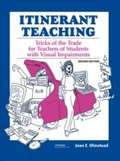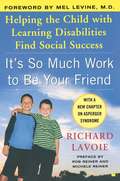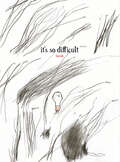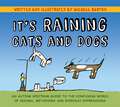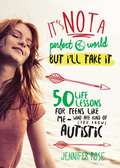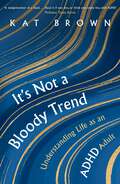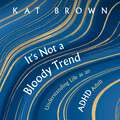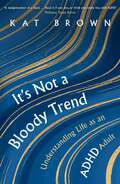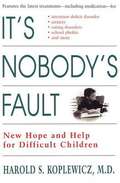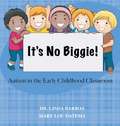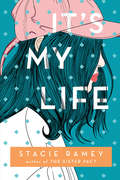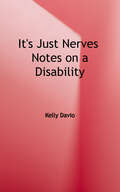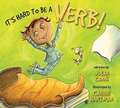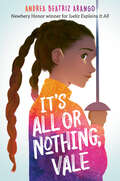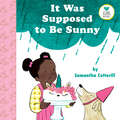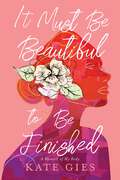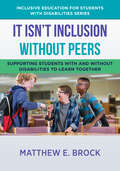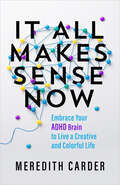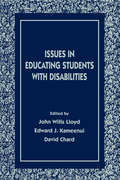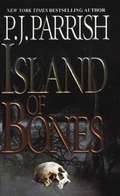- Table View
- List View
Itinerant Teaching: Tricks of the Trade for Teachers of Students with Visual Impairments (Second Edition)
by Jean E. Olmstead'Itinerant Teaching' is full of tips, techniques and strategies that will help teachers of visually impaired students to organize their time, events and activities effectively.
It's So Much Work to Be Your Friend: Helping the Child with Learning Disabilities Find Social Success
by Richard LavoieAs any parent, teacher, coach, or caregiver of a learning disabled child knows, every learning disability has a social component. The ADD child constantly interrupts conversations and doesn't follow directions. The child with visual-spatial issues loses his belongings and causes his siblings to be late to school. The child with paralinguistic difficulties appears stiff and wooden because she fails to gesture when she talks. These children are socially out of step with their classmates and peers, and often they are ridiculed or ostracized for their differences. A successful social life is immeasurably important to a child's happiness, health, and development, but until now, no book has provided practical, expert advice on helping learning disabled children achieve social success. For more than thirty years, Richard Lavoie has lived with and taught learning disabled children. His bestselling PBS videos, including How Difficult Can This Be?: The F.A.T. City Workshop, and his sellout lectures and workshops have made him one of the most popular and respected experts in the field. At last, Rick's pioneering techniques for helping children achieve a happy and successful social life are available in book form. It's So Much Work to Be Your Friend offers practical strategies to help learning disabled children ages six through seventeen navigate the treacherous social waters of their school, home, and community. Rick examines the special social issues surrounding a wide variety of learning disabilities, including ADD and other attentional disorders, anxiety, paralinguistics, visual-spatial disorders, and executive functioning. Then he provides proven methods and step-by-step instructions for helping the learning disabled child through almost any social situation, including choosing a friend, going on a playdate, conducting a conversation, reading body language, overcoming shyness and low self-esteem, keeping track of belongings, living with siblings, and adjusting to new settings and situations. Perhaps the most important component of this book is the author's compassion. It comes through on every page that Rick feels the intensity with which children long for friends and acceptance, the exasperation they can cause in others, and the joy they feel in social connection. It's So Much Work to Be Your Friend answers the most intense yet, until now, silent need of the parents, teachers, and caregivers of learning disabled children -- or anyone who is associated with a child who needs a friend.
It's So Difficult
by Raúl Nieto GuridiA school day can be so overwhelming: so many people, so many noises, so many things to remember. Grown-ups say it&’ll get easier with time, but even saying hello is incredibly hard. Thank goodness for comforts like math, for anything that can relax a restless mind. Maybe this time a few words will come out at last…An empathetic look at anxiety and overstimulation, It&’s So Difficult follows a child throughout the challenging routines of a single day. Even the smallest step forward can be an enormous triumph.
It's Raining Cats and Dogs: An Autism Spectrum Guide to the Confusing World of Idioms, Metaphors and Everyday Expressions
by Michael Barton Delia BartonThe English language can be extremely confusing and illogical, especially for people with an autism spectrum disorder (ASD) who interpret meaning in a very literal way. Why should an announcement that cats and dogs are falling from the sky indicate heavy rain? And what have chickens got to do with being a coward? It's Raining Cats and Dogs is a witty and stylish insight into the mind of someone with an ASD. It beautifully illustrates why people with ASDs have problems understanding common phrases and idioms that others accept unquestioningly as part of everyday speech. The quirky drawings will entertain and inspire those on the spectrum, giving them the confidence to recognise figures of speech, feel less alienated and even use idioms themselves. The drawings will form instantly memorable references for those with ASDs to recall whenever they need to and will be helpful for anyone curious to understand the ASD way of thinking. They will enable people on the spectrum and their friends, families, teachers and colleagues to better understand and communicate with each other.
It's Only a Mountain: Dick and Rick Hoyt, Men of Iron
by Samuel E. NallIn Dick Hoyt's world the only difference between and hill and mountain is something called attitude, and along with their courage and determination, the Hoyt family has conquered many mountains the past forty years, literally and figuratively. They were devastated when their first son was born with cerebral palsy, a non-vocal quadriplegic but they accepted the challenge. Rather than put Rick in an institution and forget him - as was suggested by the doctors - they gave him a life unlike any other. ESPN, ABC, and NBC brought national attention to Team Hoyt when they conquered the Ironman Hawaii and again they traversed the Rocky Mountains on a bicycle. Dick a novice swimmer tethers himself to a rubber dinghy and tows his adult son 2.4 miles in the Pacific Ocean. He straps Rick to a seat on the front of a custom built bicycle and pedals 112 miles. Together they then complete the Ironman events by running a marathon 26.2 miles, with Rick seated in a running chair. 'These are tremendous accomplishments, of course, but they represent only couple of the rungs in Team Hoyt's inspirational ladder. If you are expecting a simple sports biography, or only a story about a man competing in triathlons and marathons, you are in for a pleasant surprise. That is not what you will din between the covers of this book. Instead, prepare for and emotional saga about the tremendous accomplishments of a handicapped person surrounded by a family motivated by love for one another and for humanity in general!
It's Not a Perfect World, but I'll Take It: 50 Life Lessons for Teens Like Me Who Are Kind of (You Know) Autistic
by Jennifer RoseJennifer Rose is autistic. She’s also a college student who loves reading, writes fan fiction, and wants to be on TV someday. She sees the world a little differently than most people around her. She’s had trouble coping with school and she’s struggled with bullies, mean girls, and her own feelings of bitterness and inferiority. Through it all, with the help of her parents, she’s learned a few lessons: #5: There are many ways to make a difference. #20: You won’t be perfect at everything, not even the things you do best. #22: Down times will be bouncing up soon . . . #23: . . . but meanwhile, try to enjoy what you have. #44: Talk about your feelings, even when it’s hard. #45: Learn to take jokes, even your dad’s. It's Not a Perfect World but I’ll Take It is an uplifting ode to being different. Told with irresistible honesty and humor, Rose’s fifty bite-sized stories will have teens and adults nodding in recognition and discovering new things about themselves.
It's Not A Bloody Trend: Understanding Life as an ADHD Adult (Bionic Text Edition)
by Kat BrownNobody should spend their life feeling defective. Everyone deserves to have a user manual to their brain - welcome to yours. Once associated more with hyper boys than adults, ADHD (attention deficit hyperactivity disorder) is now recognised as a condition in need of a rebrand which affects people of all genders and ages in a multitude of ways. In this enlightening and definitive layman's guide, Kat Brown cheerfully smashes the stereotypes with scientific evidence, historical context, and practical support for ADHD minds across areas that can cause problems, from finances and work to self-medicating, relationships, hormones and self-esteem. Based on Kat's personal experience and extensive interviews with ADHDers and world-leading clinical experts, It's Not A Bloody Trend is for anyone wondering if what's always been 'wrong' with them might just be undiagnosed ADHD.
It's Not A Bloody Trend: Understanding Life as an ADHD Adult (Bionic Text Edition)
by Kat Brown'A sledgehammer of a book putting to bed all the cynicism and misinformation around a condition that affects so many hidden, brilliant people' Professor Tanya Byron'Laugh out loud funny and deeply validating - every person who thinks ADHD isn't real should read this book' Leanne Maskell, author of ADHD: An A to ZNobody should spend their life feeling defective. Everyone deserves to have a user manual to their brain - welcome to yours. Once associated more with hyper boys than adults, ADHD (attention deficit hyperactivity disorder) is now recognised as a condition in need of a rebrand which affects people of all genders and ages in a multitude of ways. In this enlightening and definitive layman's guide, Kat Brown cheerfully smashes the stereotypes with scientific evidence, historical context, and practical support for ADHD minds across areas that can cause problems, from finances and work to self-medicating, relationships, hormones and self-esteem. Based on Kat's personal experience and extensive interviews with ADHDers and world-leading clinical experts, It's Not A Bloody Trend is for anyone wondering if what's always been 'wrong' with them might just be undiagnosed ADHD.
It's Not A Bloody Trend: Understanding Life as an ADHD Adult
by Kat Brown'A sledgehammer of a book putting to bed all the cynicism and misinformation around a condition that affects so many hidden, brilliant people' Professor Tanya Byron'Laugh out loud funny and deeply validating - every person who thinks ADHD isn't real should read this book' Leanne Maskell, author of ADHD: An A to ZNobody should spend their life feeling defective. Everyone deserves to have a user manual to their brain - welcome to yours. Once associated more with hyper boys than adults, ADHD (attention deficit hyperactivity disorder) is now recognised as a condition in need of a rebrand which affects people of all genders and ages in a multitude of ways. In this enlightening and definitive layman's guide, Kat Brown cheerfully smashes the stereotypes with scientific evidence, historical context, and practical support for ADHD minds across areas that can cause problems, from finances and work to self-medicating, relationships, hormones and self-esteem. Based on Kat's personal experience and extensive interviews with ADHDers and world-leading clinical experts, It's Not A Bloody Trend is for anyone wondering if what's always been 'wrong' with them might just be undiagnosed ADHD.
It's Not A Bloody Trend: Understanding Life as an ADHD Adult
by Kat BrownBIONIC TEXT FORMAT ALSO AVAILABLE'A sledgehammer of a book putting to bed all the cynicism and misinformation around a condition that affects so many hidden, brilliant people' Professor Tanya Byron'Laugh out loud funny and deeply validating - every person who thinks ADHD isn't real should read this book' Leanne Maskell, author of ADHD: An A to ZNobody should spend their life feeling defective. Everyone deserves to have a user manual to their brain - welcome to yours. Once associated more with hyper boys than adults, ADHD (attention deficit hyperactivity disorder) is now recognised as a condition in need of a rebrand which affects people of all genders and ages in a multitude of ways. In this enlightening and definitive layman's guide, Kat Brown cheerfully smashes the stereotypes with scientific evidence, historical context, and practical support for ADHD minds across areas that can cause problems, from finances and work to self-medicating, relationships, hormones and self-esteem. Based on Kat's personal experience and extensive interviews with ADHDers and world-leading clinical experts, It's Not A Bloody Trend is for anyone wondering if what's always been 'wrong' with them might just be undiagnosed ADHD.
It's Not A Bloody Trend: Understanding Life as an ADHD Adult
by Kat BrownBIONIC TEXT FORMAT ALSO AVAILABLE'A sledgehammer of a book putting to bed all the cynicism and misinformation around a condition that affects so many hidden, brilliant people' Professor Tanya Byron'Laugh out loud funny and deeply validating - every person who thinks ADHD isn't real should read this book' Leanne Maskell, author of ADHD: An A to ZNobody should spend their life feeling defective. Everyone deserves to have a user manual to their brain - welcome to yours. Once associated more with hyper boys than adults, ADHD (attention deficit hyperactivity disorder) is now recognised as a condition in need of a rebrand which affects people of all genders and ages in a multitude of ways. In this enlightening and definitive layman's guide, Kat Brown cheerfully smashes the stereotypes with scientific evidence, historical context, and practical support for ADHD minds across areas that can cause problems, from finances and work to self-medicating, relationships, hormones and self-esteem. Based on Kat's personal experience and extensive interviews with ADHDers and world-leading clinical experts, It's Not A Bloody Trend is for anyone wondering if what's always been 'wrong' with them might just be undiagnosed ADHD.
It's Nobody's Fault: New Hope and Help for Difficult Children and Their Parents
by Harold S. KoplewiczA guide for parents of troubled children provides compassionate advice on the diagnosis, treatment, and prognosis for thirteen psychological disorders, including ADD, depression, and anxiety, dispelling myths about medication and other available treatments.
It's No Biggie! Autism in the Early Childhood Classroom
by Dr Linda Barboa Mary Lou DatemaWorking with young children is a rewarding job, but it's also challenging, even on the best of days. Early childhood teachers work with a variety of abilities and behaviors and make hundreds of decisions daily that affect the lives of children. As a teacher, having a bag of tricks that contains knowledge of child development as well as specific strategies to use in handling issues that arise is necessary. This book gives a basic understanding of child development that will help teach all the children who fall outside the "box" or along the autism spectrum, with or without a diagnosis. The basic behavioral concepts and strategies in this book will provide a foundational knowledge of child development. The more specific teaching tips will give a variety of ways to work with children who have additional challenges. When armed with knowledge of child development, an understanding of the autism spectrum, and good practical strategies for intervention will able to make an inclusive classroom, a great place to be for everyone.
It's My Life
by Stacie RameyIf she wants a future with him, she'll have to make peace with her past.Jenna's never let her cerebral palsy get her down. But when she discovers that her condition was actually caused by an injury at birth, she's furious with her parents, who withheld the truth. And as they push her to get yet another difficult procedure, Jenna feels her control over her life starting to slip.Enter Julian, Jenna's childhood crush. He's just moved back to town, and he's struggling in school, so Jenna reaches out to him—anonymously—to help. Soon, their conversations are about so much more than class. She's falling for him all over again, hard and fast. But would Julian still be interested in her if he knew who she really was? And can she find a way to take back her own narrative before she pushes away everyone she loves?Also by Stacie Ramey:The Sister PactThe HomecomingThe Secrets We Bury
It's Just Nerves: Notes on a Disability
by Kelly DavioWith equal parts wit and empathy, lived experience and cultural criticism, Kelly Davio's It's Just Nerves: Notes on a Disability explores what it means to live with an illness in our contemporary culture, whether at home or abroad. "When the body attacks itself, the crisis is not just of bones and blood, but of beauty and boundaries. 'Strange men have had their hands on me for days, ' Kelly Davio observes during a plasma treatment. Her skillful portrait of myasthenia gravis does not exist in a vacuum. It's Just Nerves is in keen dialogue with the world around us--critiquing modern health care, pub seating etiquette, alarming election outcomes, smarmy meditation culture, and caricatures of illness in ads and on screen. 'Oxygen is delicious, ' Davio reminds us, before the fire breaks out. A brisk, funny, and at times startlingly poetic memoir." --Sandra Beasley, author of Don't Kill the Birthday Girl: Tales from an Allergic Life. "Kelly Davio's It's Just Nerves feels like the book I've been waiting for all my life. If you want to know what it feels like to be a person with a disability in the 21st century, read this book. From mindfulness to yoga pants, Davio skewers ableist fabrications and brings us to a vital, ebullient, and sometimes terrifying reckoning with our real and shared human experience. She is a very funny writer and also a fearless one. Once I started reading these essays, I couldn't put them down; they resounded through me like poetry or truth." --Sheila Black, author of House of Bone and Love/Iraq. "Kelly Davio's got so much incredible stuff brewing together on every page of these nimble, shapeshifting essays: meditations on the politics of illness, the body in crisis, the spirit in bloom, David Bowie--all of it filtered, carefully, through the lithe sensibility of a poet. The results are equal parts witty and wise, heartrending and rapturous. Man, I loved this book." --Mike Scalise, author of The Brand New Catastrophe.
It's Hard To Be A Verb!
by Julia Cook<p>Louis is a verb <p>He has a lot of trouble focusing and he is always doing something, but the problem is usually it's the wrong something. <p>It's hard to be a verb <p>My knees start itching, my toes start twitching, my skin gets jumpy, others get grumpy. <P><P> When it comes to sitting still it's just not my deal. <p>Haven't you heard. . . <p> I am a verb <p>His mom teaches him how to focus by showing him a few hands on ideas that anyone can try. <P>A must have book for all who struggle with paying attention
It's All or Nothing, Vale
by Andrea Beatriz ArangoA poignant novel in verse in which, after a life-changing accident, one girl finds her way back to her life&’s passion. From the Newbery Honor-winning author of Iveliz Explains It All.All these months of staring at the wall?All these months of feeling weak?It&’s ending—I&’m going back to fencing.And then it&’ll belike nothing ever happened.No one knows hard work and dedication like Valentina Camacho. And Vale&’s thing is fencing. She&’s the top athlete at her fencing gym. Or she was . . . until the accident.After months away, Vale is finally cleared to fence again, but it&’s much harder than before. Her body doesn&’t move the way it used to, and worst of all is the new number one: Myrka. When she sweeps Vale aside with her perfect form and easy smile, Vale just can&’t accept that. But the harder Vale fights to catch up, the more she realizes her injury isn&’t the only thing holding her back. If she can&’t leave her accident in the past, then what does she have to look forward to?In this moving novel from the Newbery Honor-winning author of Iveliz Explains It All, one girl finds her way back to her life&’s passion and discovers that the sum of a person's achievements doesn&’t amount to the whole of them.
It's $5 Extra for Cerebral Palsy
by Anthony M. Aversano Marie A. LacerraMarie A. Lacerra was born with severe Cerebral Palsy before the days of "accessibility," "normalization," and laws protecting the rights of people with disabilities. However, despite a world which was not ready for her, Marie was blessed with family and friends who were ahead of their time and not afraid to show the world who Marie was. Finally released from the prison of unintelligible speech by modern technology, Marie is now able to tell her stories --stories much like the ones we tell everyday: filled with love and laughter, tears and loss, hope and courage. With the help of a special "word hunting" computer, and a deep desire to communicate, her inspirational stories reveal the power of the human spirit and paint a vivid picture of the prejudice and difficulties a person with Cerebral Palsy must face.
It Was Supposed to Be Sunny (Little Senses)
by Samantha CotterillA perfectly planned birthday party goes awry in this gentle story about adapting to the unexpected, written for kids on the autism spectrum and called &“brilliant&” and &“engaging&” by autism specialist Tony AttwoodLaila feels like her sparkly sunshine birthday celebration is on the brink of ruin when it starts to storm. Then, just as she starts feeling okay with moving her party indoors, an accident with her cake makes her want to call the whole thing off. But with the help of her mom and a little alone time with her service dog, she knows she can handle this. Changes in routine can be hard for any kid, but especially for kids on the autism spectrum. Samantha Cotterill's fourth book in the Little Senses series provides gentle guidance along with adorable illustrations to help every kid navigate schedule changes and overwhelming social situations.
It Must Be Beautiful to Be Finished: A Memoir of My Body
by Kate GiesA raw, beautiful memoir of a girl born missing an ear, a medical system insistent on saving her from herself, and our culture&’s desire to &“fix&” bodies.When Kate Gies was four years old, a plastic surgeon pressed a synthetic ear to the right side of her head and pulled out a mirror. He told her he could make her &“whole&”—could make her &“right&”—and she believed him. From the age of four to thirteen, she underwent fourteen surgeries, including skin and bone grafts, to craft the appearance of an outer ear. Many of the surgeries failed, leaving permanent damage to her body. In short, lyrical vignettes, Kate writes about how her &“disfigured&” body was scrutinized, pathologized, and even weaponized. She describes the physical and psychic trauma of medical intervention and its effects on her sense of self, first as a child needing to be fixed and, later, as a teenager and adult navigating the complex expectations and dangers of being a woman. It Must Be Beautiful to Be Finished is the story of a girl desperately trying to have a body that makes her acceptable and of a woman learning to own a body she has never felt was hers to define. In an age of speaking out about the abuse of marginalized bodies, this memoir takes a hard look at the role of the medical system in body oppression and trauma.
It Isn't Inclusion Without Peers: Supporting Students With and Without Disabilities to Learn Together (The Norton Series on Inclusive Education for Students with Disabilities #0)
by Matthew BrockPeer-mediated interventions benefit all students in the classroom. Peer-mediated interventions are a category of practices in which students without disabilities provide academic and social support to classmates with disabilities in inclusive classrooms, cafeterias, and on playgrounds. These support strategies are shown to have positive effects on academic, interpersonal, and social development—not only for students with disabilities, but also for their classmates who serve as peer supports. Students with a variety of disabilities benefit from peer-mediated support interventions, including students with intellectual disabilities, autism spectrum disorder, and multiple disabilities. In this book, Matthew Brock provides educators with a practical guide to the implementation of peer-mediated interventions. General and special education teachers will receive expert guidance on how to decide which combination of interventions is likely to work best for each child, and how to collaborate with paraeducators and each other to implement the selected strategies.
It All Makes Sense Now: Embrace Your ADHD Brain to Live a Creative and Colorful Life
by Meredith CarderFrom the personal and coaching experience of an ADHDer, actionable tools and techniques to understand your ADHD brain and unlock life's possibilities.Do you often feel that your emotions are intense and difficult to regulate? Does boredom get to you seemingly more than most? Do you struggle with your perception of time?You're not alone. As cultural and medical awareness around ADHD shifts, millions of adults who are diagnosed with ADHD are unclear on the many ways ADHD symptoms present and how it affects the experience of their everyday life.Meredith Carder, an ADHD coach and ADHDer herself, shares real-life stories from her coaching practice and own lived experience along with actionable exercises and strategies to help you: Harness the power of self-compassion and self-awareness to embrace your unique brainBuild your own toolkit of daily habits to prevent boredom and burnoutRate your level of focus and plan your energy accordinglyLearn to appreciate your ADHD brain and empower yourself to live a life rich with interestBy learning more about the way your mind works, you too can rewrite your inner dialogue and fully realize the life you want to live.
Issues in Educating Students With Disabilities (The LEA Series on Special Education and Disability)
by Edward J. Kameenui David Chard John Wills LloydThe contributors to this volume represent the most prominent researchers and thinkers on issues in educating students with and without disabilities. The book captures the most current thinking, research, and analysis on the full range of issues in educating students with learning disabilities, from its definition to the most recent case law and interpretations of federal law on educating these students in the general education classroom. The contributors' words speak sufficiently, mellifluously, and exactingly about their contributions to the education of all students, in particular those with disabilities. This book of essays was written to pay tribute to Barbara D. Bateman, who -- along with Sam Kirk -- coined the term "learning disabilities." Its content reflects the significance of her contributions to the field of special education.
Issues in Aging and Vision: A Curriculum for University Programs and In-service Training
by Alberta L. OrrThe demographics and psychosocial aspects of aging and vision loss, community-based services for blind older persons, improving access to vision rehabilitation.
Island of Bones (Louis Kincaid #5)
by P. J. ParrishISLAND OF SECRETS. In the wake of a hurricane, a tiny bleached skull washes up in front of Detective Louis Kincaid's cottage. Days later, the bullet-ridden body of a woman surfaces on a nearby beach. She has no identification...except for a unique ring carved out of bone on her finger... ISLAND OF TERROR. Sensing a connection between the dead woman and the skull he's found, Louis starts investigating. His search for the truth will lead him down a trail of hidden secrets and lies to face utter evil on a lonely island where treachery never dies and the living never escape... ISLAND OF BONES.
